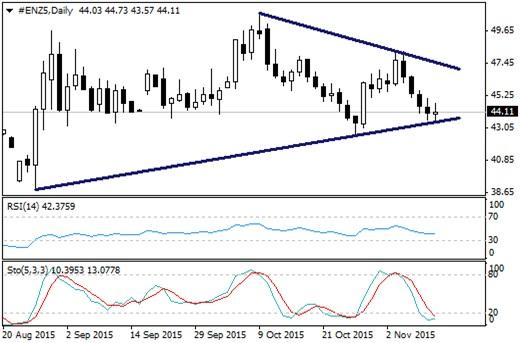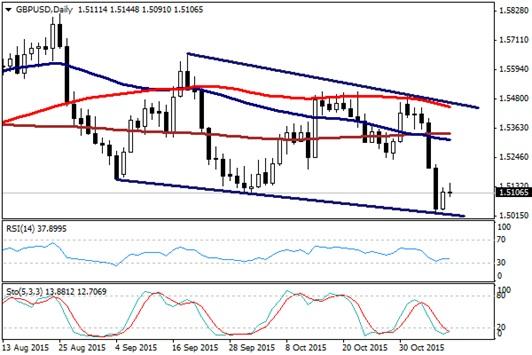Markets are set to wake up to concerns over a slowing China economy for the third successive day following annualised Industrial Production data slipping below expectations a few hours ago. This economic release adds to the underlying anxiety around economic momentum consistently declining in China, and compliments the below expectations inflation release on Tuesday morning, as well as the incredibly weak trade data that was released over the weekend.
Markets are set to wake up to concerns over a slowing China economy for the third successive day following annualised Industrial Production data slipping below expectations a few hours ago. This economic release adds to the underlying anxiety around economic momentum consistently declining in China, and compliments the below expectations inflation release on Tuesday morning, as well as the incredibly weak trade data that was released over the weekend.
Although China GDP has slipped below the government target and all indications currently point towards economic momentum continuing to decline, its domestic growth is still phenomenal and a slowing down overall economy will not cause too many concerns domestically unless it begins to negatively impact local employment. It is an issue for all of those economies that have become reliant on trade with China, because they are basically going to inevitably notice slowing demand for products from China.
Along with the consistent uncertainty over the timing of a US interest rate rise, the resumption of fears over the slowing China economy have contributed behind the losses seen in equity markets during the early part of the week. Overall, the economic data that has been released from China over the past couple of days is just going to install further pressure on the People’s Bank of China (PBoC) to ease monetary policy further in the hope of reinvigorating economic data. I still see the heightened potential for one more interest rate cut before the end of the year.
EURUSD falls to six-month low
The resumption of an obvious contrast in both economic and monetary sentiment between the United States and Europe has encouraged sellers to attack the Eurodollar. The pair has now fallen to a six-month low at 1.0673 and the markets are all of a sudden returning to talking about a potential move to parity before the end of the current year. For the chances of this to increase the Federal Reserve would need to provide further encouragement to traders that they will begin raising US interest rates next month, while the European Central Bank (ECB) would also have to continue repeating the threat of providing further stimulus to the European economy.
It is important to point out that the only major reason for the Eurodollar bouncing away from its 11-year low at 1.04 earlier this year to above 1.15 was due to continually pushed back US interest rate expectations, meaning any emerging concerns that the Federal Reserve might not raise US interest rates next month despite the superb NFP report on Friday could motivate a recovery of recent losses in the pair.
IEA sees oil below $80 until 2020
Any optimism over WTI Oil trading back towards $100 received a serious blow after the International Energy Agency (IEA) predicted that prices are unlikely to rise consistently above $80 before the end of the decade. The combination of an aggressive oversupply in the markets and slowing demand for the commodity were cited as the major reasons against a major rebound in the commodity. The only difficulty with believing this prediction is that it is too difficult to predict where prices could be one year from now, let alone for the remainder of the current decade.
In the meantime, the repeated signs of there being an aggressive oversupply of oil in the markets will continue to negatively impact investor attraction towards the commodity. Not only are US inventories still around near-record levels, but increased production is being announced elsewhere and Iran is expected to begin unleashing their own supplies at some point in the near future. Although there is one final OPEC meeting scheduled before the end of the year, it is looking very unlikely that there will be a production cut and this makes it difficult to predict a significant recovery in WTI before the end of the year.
In regards to the technicals on the daily timeframe, we are currently noticing WTI trading in an inverted wedge pattern. We have bounced away from the lower channel of this pattern over the past two days, and the Stochastic signaling that it is oversold indicates that prices could continue to trade higher. With that being said, there is an oversupply in the markets and the current fears over the global economy can lead to less demand for the commodity. A break below the trendline would open up the gates to a move towards $42 and if this breaks, a potential move towards $40.
In regards to the technicals on the daily timeframe, we are currently noticing WTI trading in an inverted wedge pattern. We have bounced away from the lower channel of this pattern over the past two days, and the Stochastic signaling that it is oversold indicates that prices could continue to trade higher. With that being said, there is an oversupply in the markets and the current fears over the global economy can lead to less demand for the commodity. A break below the trendline would open up the gates to a move towards $42 and if this breaks, a potential move towards $40.
GBPUSD attempting to recover losses
After experiencing another technical rejection at 1.55 early last week, the GBPUSD has encountered an aggressive sell-off and the pair is currently attempting to recover losses following a sudden decline to its lowest valuation in over six months at 1.5026. Technically speaking, the GBPUSD continues to look weak and the bounce back above 1.51 during the early part of the current week can be considered as a recovery of recent heavy losses.
With that being said, the GBPUSD has bounced away from its descending channel after testing the lower trendline and with both the RSI and Stochastic attempting to move away from the oversold boundaries, the pair could still aim to recover some further losses.
Although the majority of UK headlines are focusing on UK Prime Minister David Cameron and a potential EU referendum, the latest jobless claims and average earnings are released from the UK economy on Wednesday morning. Investor sentiment towards the Pound could be lifted if further progress is recorded in the UK employment sector and if average earnings continue to improve and increase optimism around a potential rebound in inflation over the upcoming months.
Overall though, prices are currently trading below both of its 50 and 200 MA’s on the Daily Timeframe, and it is currently looking ambitious to expect any potential further rally in the GBPUSD to progress any higher than 1.53.
Comparebroker is a comparison site and we spend hundreds of hours to keep the information up to date. However, users are advised to do their own due diligence and nothing can be perceived any advise. The content on the website is purely for education purposes only
Recommended Content
Editors’ Picks
EUR/USD clings to gains above 1.0750 after US data

EUR/USD manages to hold in positive territory above 1.0750 despite retreating from the fresh multi-week high it set above 1.0800 earlier in the day. The US Dollar struggles to find demand following the weaker-than-expected NFP data.
GBP/USD declines below 1.2550 following NFP-inspired upsurge

GBP/USD struggles to preserve its bullish momentum and trades below 1.2550 in the American session. Earlier in the day, the disappointing April jobs report from the US triggered a USD selloff and allowed the pair to reach multi-week highs above 1.2600.
Gold struggles to hold above $2,300 despite falling US yields

Gold stays on the back foot below $2,300 in the American session on Friday. The benchmark 10-year US Treasury bond yield stays in negative territory below 4.6% after weak US data but the improving risk mood doesn't allow XAU/USD to gain traction.
Bitcoin Weekly Forecast: Should you buy BTC here? Premium

Bitcoin (BTC) price shows signs of a potential reversal but lacks confirmation, which has divided the investor community into two – those who are buying the dips and those who are expecting a further correction.
Week ahead – BoE and RBA decisions headline a calm week

Bank of England meets on Thursday, unlikely to signal rate cuts. Reserve Bank of Australia could maintain a higher-for-longer stance. Elsewhere, Bank of Japan releases summary of opinions.

